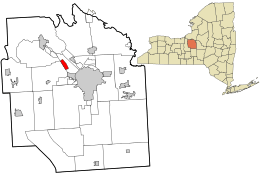Lakeland, New York facts for kids
Quick facts for kids
Lakeland, New York
|
|
|---|---|

Location in Onondaga County and the state of New York.
|
|
| Country | United States |
| State | New York |
| County | Onondaga |
| Area | |
| • Total | 1.49 sq mi (3.86 km2) |
| • Land | 1.49 sq mi (3.86 km2) |
| • Water | 0.00 sq mi (0.00 km2) |
| Elevation | 479 ft (146 m) |
| Population
(2020)
|
|
| • Total | 2,556 |
| • Density | 1,714.29/sq mi (661.71/km2) |
| Time zone | UTC-5 (Eastern (EST)) |
| • Summer (DST) | UTC-4 (EDT) |
| FIPS code | 36-40607 |
| GNIS feature ID | 0954952 |
Lakeland is a small community in Onondaga County, New York, United States. It is known as a hamlet and a census-designated place. In 2010, about 2,786 people lived here. The community gets its name because it is located right next to Onondaga Lake.
Lakeland is found in the northwest part of the town of Geddes.
Contents
History of Lakeland
In the late 1800s and early 1900s, Lakeland was a popular vacation spot. It had fancy hotels and a small amusement park along the shores of Onondaga Lake. A trolley car line from Syracuse brought visitors to these resorts.
However, the resort area started to become less popular before World War I. By the time of the Great Depression, it was completely gone. Today, much of this former resort area is covered by Interstate 690. It also includes parking lots for the New York State Fair, which has its permanent home at the southern edge of Lakeland.
The 1943 Industrial Waste Flood
On Thanksgiving Day in 1943, a large amount of industrial waste flooded Lakeland. About 40,000 tons of materials like calcium carbonate and magnesia broke through a wall at the Solvay Process Company plant.
The flood covered two square miles, with the waste reaching up to eight feet deep in some spots. A newspaper reported that "every tree, shrub or blade of grass within a square mile was dead." Cars parked in the area were stuck and covered by the waste. One car at the fairgrounds was even swept away for 1,000 feet.
Many people helped to control the flood and rescue residents. Deputies from the Onondaga County Sheriff's Office, local fire departments, police from Solvay, and the New York State Police all responded. The American Red Cross and Solvay Process crews also joined in. Volunteers from the SPCA were there to help rescue animals.
The Red Cross set up a shelter at the State Fair Hotel. Luckily, no one died, but a few people were hurt. For example, a military policeman helping with the rescue got acid burns and frostbite on his toes. He had used a rowboat to save many people who were trapped. Several animals were rescued, but some pigs, geese, ducks, and hundreds of chickens drowned. The flood left 55 residents without homes.
Initially, workers tried to solidify the waste by dumping cinders into it. However, this plan was changed. Instead, they used water to dissolve the waste. Then, they pumped it into Ninemile Creek, which flows into Onondaga Lake. The cleanup took two months to finish. The houses that were destroyed by the flood were bought by Solvay Process and then torn down.
An investigation into the incident found that the walls at the plant were built too quickly. They were made of old waste material, not strong dirt. The investigation also noted that the demand for production during World War II was very high, and there wasn't enough help. After the flood, Solvay Process moved their waste beds away from the lake. Today, most of the affected area is a parking lot for the fairgrounds.
Community Life
Lakeland has several useful places for its residents. You can find gas stations, different food places, and a few small restaurants. There are also two churches, a car dealership, a credit union, and a hotel. The Solvay Middle School is located here. Lakeland also has a golf course. All these places are very close to the New York State Fair.
Geography of Lakeland
Lakeland is located at 43°5′36″N 76°14′45″W / 43.09333°N 76.24583°W.
According to the United States Census Bureau, the community covers about 1.5 square miles (3.86 square kilometers) of land. There is no water area within its borders.
Lakeland stretches along the northern half of the southwest side of Onondaga Lake. The lake runs from northwest to southeast. Interstate 690 also passes through the community.
Population Information
| Historical population | |||
|---|---|---|---|
| Census | Pop. | %± | |
| 2020 | 2,556 | — | |
| U.S. Decennial Census | |||
In 2000, there were 2,852 people living in Lakeland. These people lived in 1,076 households, and 800 of these were families. The population density was about 1,882 people per square mile.
About 34.2% of households had children under 18 living with them. Most households (63.0%) were married couples living together. About 21.1% of all households were made up of single individuals.
The average age of people in Lakeland was 40 years old. About 24.9% of the population was under 18 years old. About 14.9% of the population was 65 years or older.
See also
 In Spanish: Lakeland (Nueva York) para niños
In Spanish: Lakeland (Nueva York) para niños

